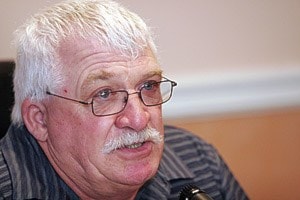The Yukon Workers’ Compensation Health and Safety Board posted a $3- million surplus in 2006.
It’s the first since 1999, board chair Craig Tuton told reporters last week.
It’s a far cry from 2002, when the board faced a $25-million deficit and “a lot of hard decisions,” Tuton said, while releasing the audited financial statements for 2006.
“The fund is healthy and the board is happy with the direction we’re going.”
The surplus was directed into the board’s reserve fund to bring it up to $31 million, which is considered the minimum amount.
Reserves help the board cover any unexpected spike in claims costs — such as a workplace catastrophe — and any fluctuations in the market that would impact the board’s revenue from investment.
Although the funds are healthy, employer assessments are still not covering the cost of claims.
The board made $4.8 million more in employer assessments in 2006 than it did in 2005.
Revenue from assessments climbed to $16.5 million from $11.6 million.
That’s a hike workers’ compensation board president Valerie Royle attributes to higher employer rates and a rise in the territory’s overall payroll.
In 2006, it paid $21 million in claims. That’s $5 million more than the $16 million it collected through assessments.
“We’re putting a lot more focus on case management and getting claims through quickly, which has decreased the cost per claim,” said Royle.
But there’s still a lot more work to be done.
Luckily, revenue from the board’s investment portfolio increased in 2006 to offset the claims costs and fuel the surplus.
The investments are split between bonds and equity investments. One third of the equity investments are Canadian, the other two thirds are in US and foreign firms.
It was a good year for the board’s investment portfolio, which grew “significantly” to $139 million from $134 million in 2005, said the board’s chief financial officer Jim Stephens.
Meanwhile, the cost of running the Workers’ Compensation Board and its 72 full-time employees increased to $7.2 million from $6.7 million in 2005.
That’s a 7.5 per cent hike, which the board attributes to a raise in its employees’ collective agreement, more spending on workplace safety initiatives and professional consulting costs.
What is Tuton’s message for employers who are unhappy because they’re paying higher rates while the board posts a surplus?
“They’re not happy because the rates are high and we at the board aren’t happy either,” said Tuton.
By partnering with stakeholders and working to reduce injury rates, the board is moving in the right direction, he added.
So far this year there have been 930 workplace injuries and one death reported in the territory, according to the scoreboard outside workers’ compensation’s Fourth Avenue office.
The sign tallies the number of reported injuries. Not every injury report becomes a claim and not every claim is accepted and paid out.
That number has gone up approximately 14 per cent from this time in 2006, which was the highest figure the territory has seen in 13 years.
The hike was not a surprise for Tuton.
“We expected the numbers to go up simply because people are more involved,” he said.
The board encourages employees to report all injuries, even the minor ones, because if they’re left unattended minor injuries may turn in to long-term disabilities.
And those disabilities could cost the system more in the long run.
